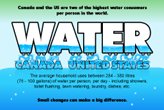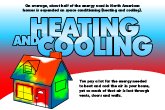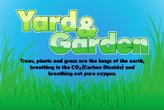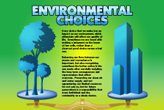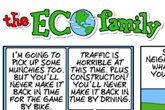- Home
- Comics
- Green Blog
-
Resources
Other Resources
-
Connect
Cracking The Recycling Code
There are still communities that do not have recycling programs and some of those that do are restrictive in what they will accept. For example, some programs will only accept certain kinds of plastic. How do you know which kinds of plastic they will accept? Usually, they will tell you by the number. I’ve done some research to help crack the recycling code.

There are 7 different numbers of plastic codes and most things have their particular number stamped in on the bottom in the middle of a triangle made from arrows. Each number identifies the kind of plastic that the item is made from.
1 is Polyethylene Terephthalate. It is also known as PET or PETE. This kind of plastic is food safe and is most commonly used in disposable soft drink and water bottles, but is also used to make bottles and jars to contain food and condiments. PET plastic is very recyclable and can be shredded and reprocessed to make polyester which in turn can be used to make fleece for clothing, stuffing or carpet.
2 is High Density Polyethylene, also known as HDPE. This plastic is food safe and is commonly used to make milk jugs and also for packaging soaps and cleaning products. Other uses are for for making plastic grocery or garbage bags. It is also an easy plastic to recycle. Because it doesn’t easily break down under outdoor conditions like heat and sun, other common uses are to make plastic wood, waste bins, and park benches.

3 is Polyvinyl Chloride or PVC. It is not considered to be food safe, however some plastic wrap, especially the film that your meat from the grocery store comes wrapped in might be #3. It also can be used to make toys, containers for cleaning products, raincoats and jewellery. It is also commonly used for plumbing pipes, window frames and garden pots and trellises. PVC is difficult to recycle.
4 is Low Density Polyethylene, LDPE and is considered to be food safe. It is used to make cling wrap, shopping bags and some reusable drink and food storage containers. Some baby bottles are made from LDPE. It is harder to recycle, but can be used to make plastic lumber or floor tiles.
5 is Polypropylene also known as PP is considered food safe and is used in things like dairy containers and reusable containers for storing food or drinks. It is also used as the liner in your cereal box, bottle tops, potato chip bags and disposable diapers. PP is recyclable, but often in not taken in recycling programs.
6 is Polystyrene, PS and is most commonly used to make egg cartons, meat and bakery trays, take out food cartons and hot drink cups. It is also used to make some plastic cutlery. Although it has been coded as generally food safe, it is very difficult to recycle and although it breaks into pieces (and then is carried by the wind) it does not break down. It is considered to be one of the most environmentally unfriendly plastics.

7 stands for “Other” which includes Polycarbonate, BPA , Lexan and bio-based polymers. It's a catch-all category that is used for all the other plastics that do not fall in the above 1-6 categories. This category could have BPA (but not necesarily) which has recently been in the news associating health risks with exposure, particularly to children. Compostable plastics (made from cornstarch) also fall into this category but have the added initials PLA under the symbol or be labeled as compostable. PLA plastics are compostable, but not recyclable.
My conclusions are that if you need to buy products packaged in plastic or plastic products, your best bets are to stick with #1 or #2 plastics whenever possible, as these are not only food safe (a consideration for children's toys as well), but are the most recyclable of all the categories.
Blog Category:
RRR
Environmental Choices

